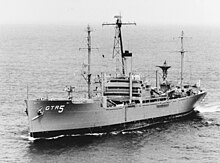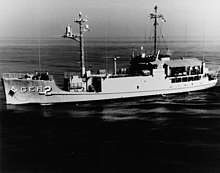Technical research ship

Technical research shipswere used by theUnited States Navyduring the 1960s to gatherintelligenceby monitoring, recording and analyzingwirelesselectronic communicationsof nations in various parts of the world. At the time these ships were active, the mission of the ships was covert and discussion of the true mission was prohibited ( "classified information"). The mission of the ships was publicly given as conducting research into atmospheric and communications phenomena. Their designation was AGTR – Auxiliary, General, Technical Research – but it was more or less anopen secretthat this was a euphemism and they were commonly referred to as "spy ships".[1][2]
Function
[edit]These ships carried a crew of U.S. Navy personnel whose specialty was intercepting wireless electronic communications and gathering intelligence from those communications (signals intelligence,communications intelligence,andelectronic signals intelligence(SIGINT)). In the 1960s those personnel had a U.S. Navyratingof Communications Technician (later changed toCryptologic Technician), or CT.
In order to transmit intelligence information that had been gathered back to United States for further processing and analysis, these ships had a special system named Technical Research Ship Special Communications, or TRSSCOM (pronounced tress-com).[3]ThisEarth-Moon-Earth (EME)communications system used a specialgyroscope-stabilized 16-foot (4.9 m)parabolic antenna,which can be seen aft of the mainsuperstructurein the accompanying photographs ofBelmontandLiberty.Radio signals were transmitted toward the Moon, where they would bounce back toward the Earth and be received by a large 84-foot (26 m) parabolic antenna at a Naval Communications Station inCheltenham, Maryland(nearWashington, D.C.) orWahiawa,Hawaii.Communications could occur only when the Moon was visible simultaneously at the ship's location and in Cheltenham or Wahiawa. The gyro stabilization of the antenna kept the antenna pointed at the Moon while the ship rolled and pitched on the surface of the ocean.
These ships were classified as naval auxiliaries with ahull designationof AGTR, which stands for Auxiliary, General, Technical Research. Five of these ships were built with hull numbers of 1–5. The first three ships of this type (Oxford,Georgetown,andJamestown) were converted from World War II-eraLiberty ships.The last two ships (BelmontandLiberty) were converted fromVictory ships.[3]The former Liberty ships' top speed of 11knots(20 km/h; 13 mph) limited the first three AGTRs to missions of slow steaming on station with a minimum of transits.[3]Victory ships' sustained speed of 18 knots (33 km/h; 21 mph) enabledBelmontto shadowMediterranean Seaoperations of theSoviethelicopter carrierMoskvain 1969.[3]All of the technical research ships weredecommissionedand stricken by 1970.
One of these ships' crew received aPresidential Unit Citationfor heroism in combat.USSLibertywasattacked,severely damaged and 34 crew members killed by shelling,napalmbombing and torpedoing fromIsraelijet fighter aircraft andmotor torpedo boatson June 8, 1967.
USSJamestownwas awarded a Meritorious Unit Commendation along withUSSOxford.The citation reads (in part) "For meritorious service from 1 November 1965 to 30 June 1969 while participating in combat support operations in Southeast Asia. Through research and the compilation of extremely valuable technical data, USSJamestownand USSOxfordcontributed most significantly to the overall security of the United States and other Free World forces operating in support of the Republic of Vietnam. SignedE.R. Zumwalt,Admiral, USN,Chief of Naval Operations."
For specifications of these ships, see Liberty ship and Victory ship.
Ships of the AGTR type
[edit]- (dates of commissioning–decommissioning)
- Oxfordclass(Liberty ship type)
- USSOxford• 1961–1969
- USSGeorgetown• 1963–1969
- USSJamestown• 1963–1969
- Belmontclass (Victory ship type)
- USSBelmont• 1964–1970
- USSLiberty• 1964–1968
Environmental research ship (AGER)
[edit]
Three smaller ships, former Army Freight Supply (FS) ships converted by Navy to Light Cargo Ship (AKL) vessels and then toBanner-class environmental research ships(AGER)[3][4]had a similar mission. In contrast to the high freeboard of the AGTR Liberty and Victory hulls, the AGER decks were low and vulnerable to boarding from small craft.[3]USSPueblo,technically still in commission, has been held byNorth Koreasince its attack and capture by on January 23, 1968.[5]
Ships of the AGER type
[edit]- USSBanner(redesignated from AKL-25/T-AKL-25, ex Army FS-345)[6]
- USSPueblo(redesignated from AKL-44, ex Army FS-344)[7]
- USSPalm Beach(redesignated from AKL-45, ex U.S. Army FS-217)[8]
Auxiliary General (AG) USNS ships
[edit]
Three technical research ships were operated asUSNSships with aMilitary Sea Transportation Servicecivilian crew and a Navy detachment conducting the mission operations. Two ships were Maritime Commission C1-M-AV1 types. One,USNSLT. James E. Robinson,was a VC2-S-AP2 (Victory) type that operated in this role December 1962-April 1964 before being reclassified AK‑274 and resuming cargo operations.[9]
- USNSPrivate Jose F. Valdez(Maritime Commission C1-M-AV1 type)[10]
- USNSLT. James E. Robinson(Maritime Commission VC2-S-AP2 (Victory) type)[11]
- USNSSgt. Joseph E. Muller(Maritime Commission C1-M-AV1 type)[12]
See also
[edit]- Spy ship
- USSParche(SSN-683)andUSSJimmy Carter(SSN-23),nuclear submarines modified or designed for intelligence gathering.
- USSSphinx,modified for electronic surveillance in El Salvador and Nicaragua area (1985-1987).
- List of research vessels – United States
- Naval trawler
References
[edit]- ^Lee, Bill (June 2013)."Spy Ships: Cold War Warriors Created at NNS"(PDF).Explorer Magazin.p. [1], 2.Archived(PDF)from the original on 10 November 2023.Retrieved10 November2023.
- ^Polmar, Norman;Mathers, Lee J. (2023).Spy Ships: One Hundred Years of Intelligence Collection by Ships and Submarines.Lincoln, NE: Potomac Books, an imprint of theUniversity of Nebraska Press.p. 97.ISBN9781640124752– viaGoogle Books.
- ^abcdefHolhaus, H. L. (September 1977). "Comment and Discussion".Proceedings.United States Naval Institute.
- ^"Environmental Research Ship (AGER) Index".NavSource Photo Archives.Retrieved9 January2012.
- ^"USS Pueblo (AGER 2)".Naval Vessel Register.United States Navy.Retrieved2008-12-23.
- ^"USSBanner(AGER-1) ".NavSource Photo Archives.Retrieved9 January2012.
- ^"USSPueblo(AGER-2) ".NavSource Photo Archives.Retrieved9 January2012.
- ^"USSPalm Beach(AGER-3) ".NavSource Photo Archives.Retrieved9 January2012.
- ^"Lt. James E. Robinson".Dictionary of American Naval Fighting Ships.Naval History and Heritage Command.Retrieved9 January2012.
- ^"USNS Pvt. Jose F. Valdez (T-AG-169)".NavSource Photo Archives.Retrieved9 January2012.
- ^"USNS LT. James E. Robinson (T-AK-274)".NavSource Photo Archives.Retrieved9 January2012.
- ^"USNS Sgt. Joseph E. Muller (T-AG-171)".NavSource Photo Archives.Retrieved9 January2012.
External links
[edit]- The "Special Project Fleet" 1961-69, 1985-89 in America's Cold War Infrastructure by Al Grobmeier
- Unofficial ship pages:
- USSOxford— Navsource Online
- USSOxford
- USSGeorgetownArchived2014-01-05 at theWayback Machine
- USSJamestown
- USSJamestown
- USSBelmont
- USSLibertymemorial
- USSLiberty
